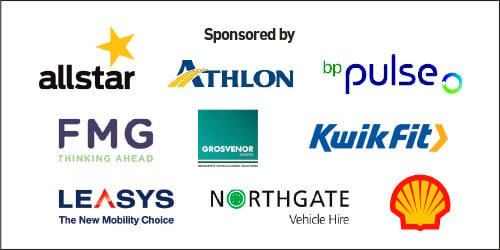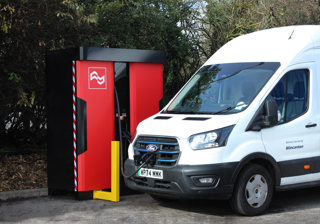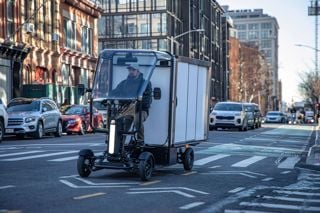This feature was taken from our special Leadership in fleet report. Click here to read it.

The most obvious – and often the best – route to decarbonise a fleet is to replace internal combustion engine (ICE) vehicles with electric alternatives on a like-for-like basis.
However, while this tackles the tailpipe emissions, for organisations which operate in urban areas this will do nothing to reduce congestion, improve journey times and miss an opportunity to reduce operating costs.
“Micromobility and e-scooters are essential pieces of the puzzle in decarbonising transport; there is an opportunity for them to support public transport, private travel and fleets,” says Beth Morley, mobility and human insights manager at Cenex (the Centre of Excellence for Low Carbon and Fuel Cell Technologies).
E-cargo bikes are already being adopted in increasing numbers by organisations operating in urban areas and, while they are an obvious fit for delivery companies, fleets from other industry sectors are also embracing their benefits.
For example, construction companies Ringway and FM Conway are both using them in their operations.
In 2020, Ringway Infrastructure introduced a three-wheeled e-cargo bike in London which it used to transport materials, tools and equipment between sites.
It has also been using a four-wheeled EAV2Cubed e-cargo bike, supporting Transport for London’s highway maintenance service since March last year.
This has been used to deal with a variety of tasks, such as graffiti removals, resetting bollards, signage works and cycleway and footway defects.
“It’s about identifying those jobs where they don’t need to carry a lot of tools and equipment that could be done by cargo bike travelling around, for example, the city centre in London,” says Neil Withers, fleet and plant technical manager at Ringway.
“It gives us one of our first responders on the ground who are more visible, able to respond to relatively small reactive and remedial jobs, doing a first fix or put some traffic management in place, for example.”
Delivery opportunities
FM Conway is using e-cargo bikes as part of its work on the Illuminated River Project in London, a major public art commission for the capital’s bridges that will light up 14 central London bridges, from London Bridge to Lambeth Bridge.
Each bridge has thousands of components, consisting of nuts, bolts, connections, couplings and lots of cabling.
“We had a unique challenge in front of us with the Illuminated River Project,” says Adam Barnes, head of structures at FM Conway.
“Ultimately, they are bridges, they don’t have a postcode, they normally sit in-between boroughs, and actually stopping and parking up on bridges is very difficult.
“We had a just-in-time delivery strategy for the project. There was limited space on site, so to be able to use e-cargo bikes from our touchpoints to the site was a fantastic opportunity.
“Typically, the bikes are averaging 15.5mph. London vans, according to Transport for London (TfL) statistics do 9.8mph.
“A six-mile trip in a van is about 36 minutes. For a bike it’s 24. We are making multiple trips a day, 12 minutes per trip. It’s very easy to see why they make sense.”
Courier CitySprint was an early adopter of e-cargo bikes, introducing them for same-day deliveries in London.
They are used to replace small vans as they can carry a similar load (up to 100kg) and are more nimble as they can travel in cycle lanes. CitySprint says the bikes can deliver up to 50% faster than a small van in urban areas.
Another advantage of using e-cargo bikes is lower running costs and overheads than for a van.
“There is obviously no congestion charge, no parking, no ultra-low emission zone (ULEZ) fee and no road tax, which is a huge benefit to the company,” says Barnes.
“You’ve also got the cost of fuel. Utilising e-cargo bikes has made our carbon footprint even smaller.
“We’ve done around 7,000 miles on the bikes since we’ve had them, that means we’ve saved around 6.2 tonnes of CO2 versus a traditional small van.”
E-scooter opportunities
E-scooters share similar time and cost benefits over cars or vans, says Oscar Morgan, CEO and co-founder of e-scooter manufacturer Bo.
“One of the great advantages of e-scooters and e-bikes is that they are the most efficient mode of powered transport,” he adds.
“We use 10-14Wh per kilometre, and the most efficient electric car you can buy is around 150Wh per kilometre, so your energy consumption is reduced by a factor of 10 with one move. It’s a massive efficiency win straight out of the box.”
Morgan says potential fleet applications for e-scooters could be for employees making short trips in urban areas for appointments, such as for estate agents.
“An e-scooter is a really great option if you need huge reliability in your timing and not having to worry about parking when you get there,” he adds.
E-scooters could also be used to supplement or replace pool cars for employees to use for business trips, if the circumstances are right.
“I’m not a reductionist, I’m not someone who is promoting using less energy gratuitously, or even scaling back, but if we can do the same thing for less energy, that seems like a really positive move,” adds Morgan.
The major issue with e-scooters at the moment is they are not generally legal to use on public roads in the UK.
The lack of legislation means they are permitted to be used only if they are hired through the shared scooter trials, which have been running in England since July 2020, with active schemes in 31 locations as of October 2022.
The original deadline for the end of the trials was November 30, 2021, but trials have been extended four times:
- First to March 2022 to allow time for gathering evidence following a slower than expected start to trials during the covid-19 pandemic.
- Second to November 2022 after we issued updated guidance in February 2022 designed to enhance existing safety measures
- Third to May 31 2024, which will allow the DfT to reflect on the further analysis or evidence that may be needed and would be beneficial
- Fourth to May 2026, which will enable the DfT to build on current learning across areas including usage, safety, and environmental impacts, and to explore changing travel patterns since the coronavirus pandemic and as e-scooters become more embedded in public life.
Under the trial, more than 34 million rides – 32.6m of them outside London – have so far taken place during the trial, says shared mobility charity CoMoUK.
Up to 49% of users have reported hiring the e-scooters for travel to work or study, with 44% of regular users using them for going to or from work.
The Department for Transport estimates that in the five trial areas it assessed in depth in 2021, the mode shift away from private cars and taxis replaced between 1.2 and 1.6 million kilometres (approximately 750,000-to-one-million miles) from the beginning of the respective trials to the end of 2021.
This equates to an estimated reduction of 269-348 tonnes of CO2.
In the Queen’s Speech in May 2022, the Government committed to the legislation of e-scooters in a new Transport Bill, which it said is intended to “improve transport across the United Kingdom, delivering safer, cleaner services and enabling more innovations”.
The bill was eventually published in November and although it featured legislation to allow self-driving and remotely-operated vehicles and vessels, e-scooters were not mentioned.
Ahead of this, in July more than 50 organisations, including local authorities, environmental charities and micromobility operators sent a letter to the Prime Minister calling on the Government to legalise e-scooters.
One of the signatories was Cenex, and Morley adds: “The need for legislation and regulation currently limits the potential of micromobility in the UK.
“Government should take action soon in order to keep riders and other road users safe by addressing issues like battery standards, training and safe road usage.”
As the role of fleet decision-maker (FDM) grows ever more complex, leadership is becoming a crucial quality.
Today's successful FDMs need to lead their teams, their drivers and their key stakeholders through a multifarious range of topics, from energy management to electric vehicles (EVs), and supply chain management to automated technology.
They need to be at the forefront of industry developments to guide their company and ensure the fleet meets the business needs in the most efficient and effective way.
Professional fleet leaders have the ability to implement policies successfully, adapting to an ever-changing environment.
They experiment and are first in line to trial new initiatives. They communicate clearly and often with those around them, helping to get buy-in to new ideas.
People leadership has risen up the list of priorities thanks to the greater focus on staff wellbeing, whether that's within fleet teams themselves or among the driving workforce.
The need to transition to EVs has opened the floodgates to a new vocabulary on workplace charging infrastructure (kW, resistors, cabling, capacity overload..), plus the creation of new relationships with the distribution network operators that would have been unheard of just three or four years ago. In each case, leadership is vital.
In this special Leadership in fleet report, we look at some of the areas having the greatest effect on the way fleets operate, offering advice and insight to give FDMs the confidence to make the right decisions and form best strategies.























Login to comment
Comments
No comments have been made yet.